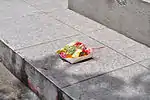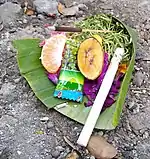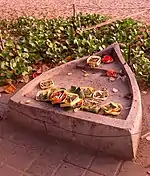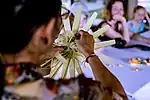
Canang sari (Balinese: ᬘᬦᬂᬲᬭᬶ) is one of the daily offerings made by Balinese Hindus to thank the Sang Hyang Widhi Wasa in praise and prayer.[1] Canang sari will be seen in the Balinese temples (pura), on small shrines in houses, and on the ground or as a part of a larger offering.[2]
Etymology
The phrase canang sari is derived from the Balinese words sari (essence) and canang (a small palm-leaf basket as the tray).[2] Canang itself consists of two syllables from the Kawi language: ca (beautiful) and nang (purpose).
Parts
Canang sari has some parts; there are peporosan, ceper, raka-raka, and sampian urasari.[2] Peporosan or the core material is made from betel leaf, banana leaf, lime, gambier, prestige, tobacco and betel nuts. Material of peporosan symbolizes the Trimurti, the three major Hindu Gods. Shiva is symbolized by lime, Vishnu is symbolized by betel nut, and Brahma is symbolized by gambier.[2] Canang sari are covered by ceper (a tray made from palm leaf) as a symbol of Ardha Candra. Raka-raka is topped with sampian urasari, which are in turn overlaid by flowers placed in a specific direction. Each direction symbolizes a Hindu God (deva):
- White-colored flowers that point to the east as a symbol of Iswara
- Red-colored flowers that point to the south as a symbol of Brahma
- Yellow-colored flowers that point to the west as a symbol of Mahadeva
- Blue or green colored flowers that point to the north as a symbol of Vishnu
A canang sari is completed by placing on top of the canang an amount of kepeng (the coin money) or paper money, which is said to make up the essence (the "sari") of the offering.[3]
Usage
Canang sari is offered every day to Sang Hyang Widhi Wasa as a form of thanking for the peace given to the world; it is the simplest daily household offering. The philosophy behind the offering is self-sacrifice in that they take time and effort to prepare. Canang sari is not offered when there is a death in the community or family.[1] Canang sari is also used on certain days, such as: Kliwon, Purnama, and Tilem.[3]
Gallery
 Young Balinese woman making canang to sell at the local pasar (market).
Young Balinese woman making canang to sell at the local pasar (market). Canang inside a car
Canang inside a car Canang on the road
Canang on the road Canang sari at Kuta Beach
Canang sari at Kuta Beach Canang sari at Kuta Beach
Canang sari at Kuta Beach With incense at a beach in Canggu
With incense at a beach in Canggu In Canggu
In Canggu.jpg.webp) Canang sari at Pura Beji Ananthaboga, Banyuwangi Regency, East Java
Canang sari at Pura Beji Ananthaboga, Banyuwangi Regency, East Java Balinese women attained flower offerings ritual in the morning
Balinese women attained flower offerings ritual in the morning A place to put canang at Kuta, Bali
A place to put canang at Kuta, Bali A Balinese woman teaching a class on how to make canang sari offerings.
A Balinese woman teaching a class on how to make canang sari offerings.
References
- 1 2 Suriyani, Luh De. "Simple and meaningful offerings are enough: Religious leader". The Jakarta Post. Archived from the original on 18 May 2013. Retrieved 8 January 2013.
- 1 2 3 4 "Meaning Canang as a Means of Prayers in the Tanah Lot". Retrieved 29 December 2012.
- 1 2 "Banten Bali". Retrieved 29 December 2012.
Further reading
- Johnston, Brian (30 June 2023). "The embarrassingly common thing in Bali most tourists know nothing about". WAtoday / Traveller. Retrieved 3 July 2023.